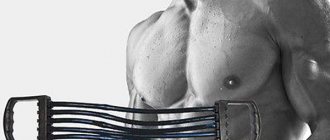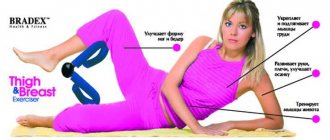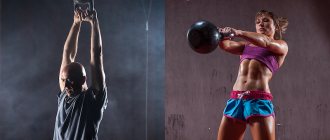Well, what woman doesn’t love a beautiful male body? Especially the fair sex are crazy about inflated male breasts and sculpted abs that you can touch.
It is very important for a modern man to have excellent physical shape, because the demands of women of our time are great.
Everyone wants to meet a handsome man with a great body. Therefore, it’s time for all men and boys to act to start winning women’s hearts.
To pump up the chest and abs, training the lower part of the pectoral muscles is best suited.
Is it necessary to pump up the lower chest?
Before we try to answer this question, let's first get acquainted with the basic knowledge of medical anatomy, which will help us understand the structure of our body.
The first thing you need to know is that the chest consists of a major and a minor muscle.
Accordingly, we are interested in the small muscle; it is this muscle that bodybuilders try so hard to pump. It plays a very important role in our structure; it is this muscle that is the most important support for the chest, that is, directly its frame.
This muscle lends itself well to heavy physical activity and, if desired, it can be pumped up to a very large size, making it visibly noticeable.
Exercise speed
This indicator must be given due attention. It is necessary to remember that the slower and with greater concentration the exercise is performed, the more thoroughly the corresponding muscle groups are worked out. In addition, performing the exercise quickly leads to a violation of the correct technique, which creates a risk of injury. Note that the first phase of all the exercises listed above for the lower chest should be slightly longer than the second phase, in other words, you need to straighten your arms faster than bend them.
Basic rules to get started
For beginning athletes who want to increase their muscle weight and get beautiful breasts and abs, the question is acute: how to pump up the lower pectoral muscles?
First of all, you need to start following proper nutrition and daily routine.
Nutrition will provide your body and muscles with nutrients, which are the building blocks for the whole body and its further development.
Exercises for the lower part of the pectoral muscles should not be started with heavy physical exertion; most likely, during the first workouts you will get a serious sprain, followed by a long recovery.
The lower part of the pectoral muscles can be loaded with heavy work after you have gained a certain mass, when you have a slight excess of subcutaneous fat in that area.
After this, you can start pumping these muscles. To get started, start following these tips, namely:
Start training hard on the uneven bars, do 3-4 sets of 10-12 times. This way you can start pumping up your chest and abdominal muscles, and also strengthen your back.
A great exercise is also the push-up. 5-6 sets of 20-25 push-ups will be enough to feel and see the result you want in the future.
Push-ups for the lower pectoral muscles are also an excellent exercise for arm strength and your endurance.
Push-ups on the uneven bars with emphasis on the chest
Regular parallel bars work great on the chest and triceps, the main thing is to know the correct technique, then you can direct a more targeted load specifically to the lower area, namely:
— You need to do push-ups with your body tilted forward, at about an angle of 30-45 degrees. For the first time, you can ask your partner to slightly raise your legs up, which will make it easier to keep your body at an angle.
— During the movement, the elbows should diverge to the sides, and not press against the body, the angle between the body and the elbows is about 45 degrees, this will allow the load to be taken from the triceps and sent to the chest.
— When doing push-ups, do not straighten your elbows completely at the top point, this will allow you to maintain the load in the chest muscles and quickly achieve muscle failure.
Types of push-ups
There are several types of push-ups in sports, which we will now tell you about in detail.
Push-ups are the most common push-ups, which give tangible results and pump up many muscles in the body. Girls can also use it.
To perform push-ups correctly, keep your head straight and spread your legs 14-15 centimeters apart. When performing the exercise, for it to be effective, do not arch your lower back, keep your back straight at all times.
Bench push-ups - take a bench and place your hands on it, then fix your body in a stationary position and start working. Bench push-ups differ from all others in their complexity.
Dips are an old and proven option that gives really good results with persistent and long-term training.
There are several nuances to it that you should be aware of. Always lean your torso forward slightly to ensure an even load on your body.
Push-ups on the horizontal bar - an untrained person is unlikely to be able to perform this exercise at least once.
First, place your hands above your head so that they are 20-25 centimeters apart from each other, secure the position of your body, do not let it sway. Then begin to smoothly pull your body up.
It is important that your chin is higher than the bar and also smoothly lower down.
To achieve results, do 3-5 sets of 7-10 pull-ups. After a month, your arms will become noticeably bigger and stronger, your chest will be more prominent and visually larger.
This way you can achieve significant results in pumping the lower pectoral muscles.
2. More exercises for the lower chest
This is the first rule that should immediately come to mind when it comes to pumping up the lower chest.
To do this, you need to pay attention to different exercises from different angles in order to include more muscles in the work and work them from all sides. To do this, use a different angle of negative inclination, set each new exercise at different angles, preventing their repetition.
An example of basic exercises is as follows:
- Head down incline press
- Dumbbell head down press
- Smith machine press with negative incline
- Dips for chest
- Angled push-ups (torso at a 30-degree angle pointing upward)
Doing exercises at home
If you don't have the financial means to go to the gym, or you're a busy person whose every minute is scheduled, then lower pectoral exercises at home are the ideal solution for you.
These exercises can be performed at home without the supervision of a professional fitness trainer. The most basic exercises will be:
- Different types of push-ups described above
- Pull-up
Girls who care about their appearance and want to be slim can also do them at home without help.
Even if you do them as a small morning exercise, you will constantly maintain your physical shape.
Or if you have just started to actively engage in physical activity, you can build muscle mass. Afterwards you should have no questions about how to pump up the lower pectoral muscles at home
Is it possible to pump up the lower pectoral muscles if they are lagging behind?
The lower pectoral muscles can lag behind for several reasons. For example, it’s genetics, or you just don’t do exercises in which the emphasis shifts to the lower chest.
In the first case, correcting the situation is much more difficult, but still possible. The main thing is persistence. If you bang your head against a wall for a long time, sooner or later you will break through it (the wall, but this is not certain). In general, the point is that if you put in maximum effort and time, then even despite terrible genetics, you can pump up your lower chest.
In the second case, the situation is more rosy. You just need to choose exercises in which the load will be directed precisely at that very lagging part . Now I’ll tell you exactly how this can be done.
Our chest is a fairly large muscle, which works entirely during basic exercises. There are no exercises that isolate only the upper, middle or lower part. So there is no such thing as lower chest muscles.
But the choice of angle determines where more load will go than on other departments. To put it very simply, where your hands are directed, that part will receive more load. If you raise your hands up, the upper part of your chest will work, if you keep them straight, the middle part will work, and if you lower your hands down, you will pump up the lower part.
I hope that you have already guessed which direction you need to pump up the lower part of the pectoral muscles.
Exercises in a professional gym
Of course, if you have money and time, then go to the gym. There you will be under the constant supervision of experienced instructors who will support you at any moment both physically and mentally, motivating you for further self-improvement.
The trainer will always give you the right recommendations, and in our case, he will tell you how to pump up the lower pectoral muscles.
Crossover exercise
This exercise is performed using two blocks, which are available in any gym. The crossover loads not only the lower part of the chest, but also its middle part, the muscles of the arms and shoulders. The crossover execution sequence is as follows:
- The athlete stands between two blocks that have special grips for one hand. Then, spreading your arms, you should take a grip on each block.
- Tightening the muscles of your chest and shoulders, you should bring your arms together in front of you. The arms remain slightly bent at the elbows.
- Return to the starting position slowly, controlling the speed of movements.
Barbell bench press
Barbell press - it is important to know that beginners should not immediately take on heavy loads.
First, grab the bar with the correct grip. Hands should be 30 centimeters apart.
When performing the exercise, inhale as you lift the bar upward, and then exhale. For beginners, 3-4 sets of 10-15 reps are best.
What exercises can you use?
It is important to note that the weight of the weights must be selected so that the last two repetitions are heavy. Do not hesitate to use the help of friends or gym mates on the last approaches. Well, and, of course, don’t forget about warming up. If you study at home, then this article will be useful to you.
Beginning of the week
- Negative incline bench press – the bench is tilted downwards and you will have to press upward, but slightly obliquely in relation to your body. If you haven’t figured it out, Google will help. 4 sets of 8–12 reps.
- The dumbbell press at a negative incline is basically the same as in the previous exercise, with the only difference being the equipment. And yes, don’t forget that you won’t be able to lift the same weight with dumbbells as you did on the barbell: there the hands work together, but here each is responsible for its own weight. 3 sets of 10 times.
- Raising dumbbells to the sides ("fly") - this exercise is not aimed at the specific development of the lower section, but at stretching the working parts of the chest. In this case - the lower beams. The more you stretch your chest, the more it should grow. But don’t overdo it - injuries have not yet been canceled. 3 to 10.
- Bending and extending the arms in support on parallel bars. Isn't that a complicated name? It would be easier to say “dip-ups.” Adjust the width of the bars so that it is not wide, but not narrow either. If the width is not adjustable, work with what you have, I’m not your help here. 3 to 15 - 18
- Pushups. Want to know what the full name of this exercise is? “Bending and extending the arms while lying down.” It's difficult, isn't it? Place your palms (and fingers) on the floor so that they form a triangle, lower them slightly down to the level of the solar plexus. Do 10-12 push-ups in 2 sets.
Additional information: it happens that the hall does not have a bench that allows you to make a negative inclination. Well, then take a bench with a positive incline, raise it almost to the end, place it under the barbell in the Smith machine and align the lowering of the barbell so that it rests squarely on your lower chest (a little lower is possible). Throw your legs (the back of your knees) over the top of the bench and lie down with your back, having previously adjusted the position of the barbell. Here's a press at a negative angle.
Weekend
- Bench press with a narrow grip - not as narrow as when working on the triceps, but not as wide as when working on the mid-chest. 4 to 8 – 12.
- Dips with additional weight - strap on an extra 8-10 kg of iron and do push-ups. Even though you may not be able to complete sets at first, do as many as you can. In total, it is advisable to do 4 sets of 6–8 times. More is possible in the future.
- Elevated push-ups - place some kind of elevation (bars, bricks, step platforms) under your palms. Due to the increased range of motion, the chest will literally burst. I generally performed this exercise, leaning on the handles of weights, for lack of anything else. Can you imagine? Simply put, he did push-ups on weights. I think you will find a way too. Do it in 3 sets of 12 – 15 times.
- "Wiring". 3 to 10, nothing new. By the way, you can do not a fly, but a “butterfly” - the same “wire”, only while sitting in the simulator.
Adviсe
To achieve a good result, first focus on those parts of the body and muscles that you want to pump up first, only after that start pumping up everything else. This method has already been proven in practice.
Vary your exercises. You don't need to do one exercise all the time, because eventually your progress will stop and your body will stop and you won't get any more results.
Perform insulating loads. This means that working with kettlebells and dumbbells at an incline will give tangible progress in the future.
Constantly add new loads to yourself. Train your body and spirit through pain. Each time, make it a priority to do more than you did yesterday, adding more weight to yourself.
After a hard workout, give your body a good rest. It is at the moment of complete relaxation that the muscles begin their accelerated recovery and begin to grow.
At the end of your workout, do a few sets of parallel bars. This way you can relieve the load from the remaining muscles and give the CNS (central nervous system) a rest.











